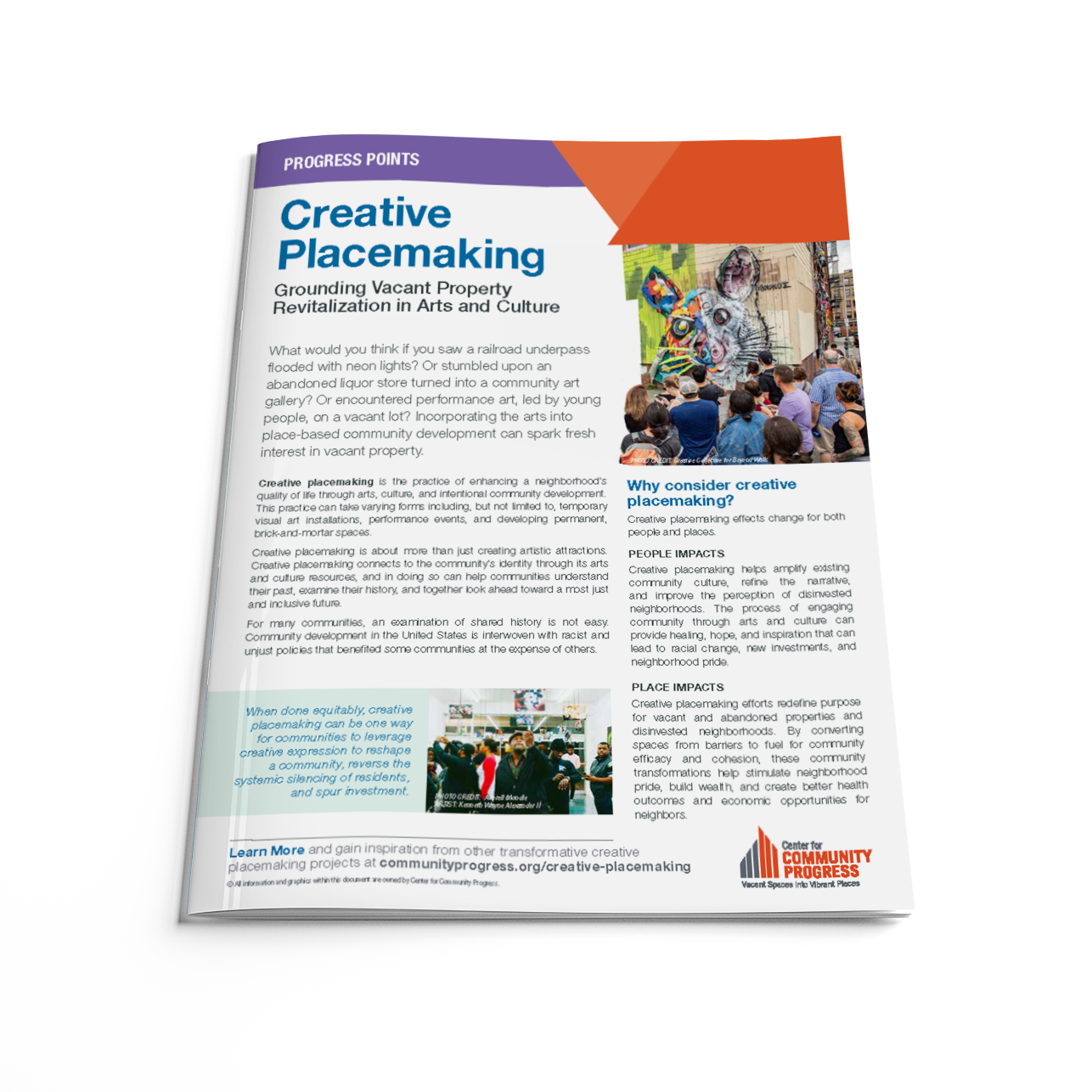
Progress Points: Creative Placemaking
A Brief Primer
Topic(s): Creative Placemaking
Published: January 2022
Geography: United States
Author(s): Center for Community Progress
What would you think if you saw a railroad underpass flooded with neon lights? Or stumbled upon an abandoned liquor store turned into a community art gallery? Or encountered performance art, led by young people, on a vacant lot? Incorporating the arts into place-based community development can spark fresh interest in vacant property.
Creative placemaking is the practice of enhancing a neighborhood’s quality of life through arts, culture, and intentional community development. This practice can take many forms, like visual art installations, performance events, developing permanent brick-and-mortar spaces, and more. These creative approaches to addressing community challenges often include repurposing vacant properties.
Creative placemaking is about more than just creating artistic attractions. It connects to community identity through arts and culture, leveraging creative expression to uplift neighborhoods and the people who live there. Creative placemaking can help communities understand their past, examine their history, and together look ahead toward a more vibrant future.
For many communities, examining shared history is not easy. Community development in the United States is entangled with racist and unjust policies that benefit some communities at the expense of others.
Why Consider Creative Placemaking?
Creative placemaking affects positive change for people and places. It amplifies existing community culture and transforms how residents—and the greater community—feel about historically disinvested neighborhoods. The process of engaging community through arts and culture can provide healing, hope, and inspiration that can lead to racial change, new investments, and neighborhood pride.
In the case of vacant, abandoned, and deteriorated properties, creative placemaking helps by giving these properties new purpose in positively contributing, rather than harming, a neighborhood. By transforming a vacant or underutilized property into a space created by, with, and for the community, it stimulates neighborhood pride, helps build wealth, and creates better health outcomes and economic opportunities for neighbors..
What are the Elements of Creative Placemaking?
Place-based: Creative placemaking is place-based. It serves a specific place and the people who live there. These projects reflect the spatial, social, and economic priorities of the neighborhood.
Connected to Local Strategies: Creative placemaking is connected to other local strategies. It works in tandem with other strategies for neighborhood revitalization, such as housing preservation or development, economic development, and resident-serving programs.
Community-centered: Creative placemaking engages residents, business owners, and local leaders to inform what the place can or should be. These people are the decision-makers for the future of their neighborhood and should drive the project’s intention.
Creative Placemaking in Action
A growing number of creative placemaking efforts are happening on vacant, abandoned, and underutilized properties, from one-off events to long-term plans that incorporate arts and culture more systemically.
Creative placemaking in action on vacant, abandoned, and deteriorated properties looks different across each project and community. When community members in Lynn, Massachusetts grew tired of the unfair reputation that their city was unsafe, they brought their community together in colorful, vibrant ways by thinking outside the box. Driven to reclaim the narrative of their neighborhood, residents focused on making downtown a more enjoyable place. In just two years the Beyond Walls Mural Festival installed 46 murals in the small seaside town and brought together hundreds of festival participants.
Topic(s): Creative Placemaking
Published: January 2022
Geography: United States
Related Publications
Other Related Content
Get the latest tools, resources, and educational opportunities to help you end systemic vacancy, delivered to your inbox.
